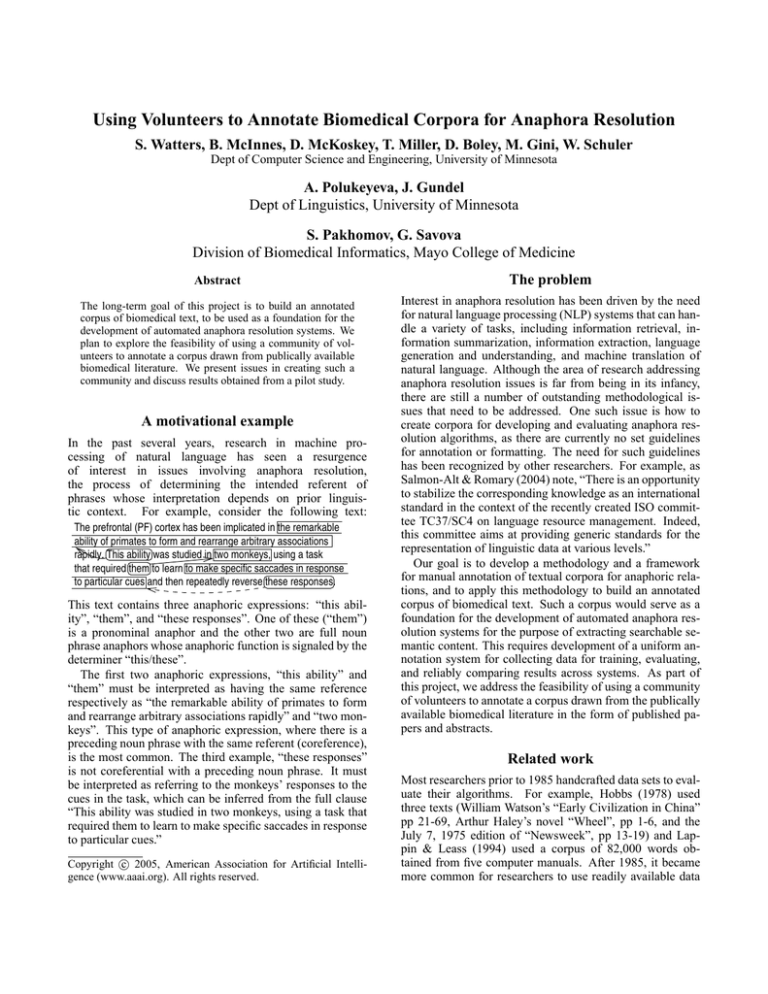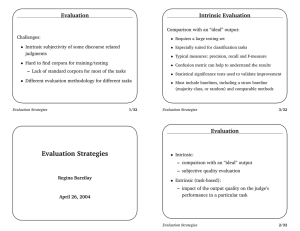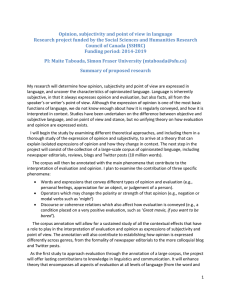
Using Volunteers to Annotate Biomedical Corpora for Anaphora Resolution
S. Watters, B. McInnes, D. McKoskey, T. Miller, D. Boley, M. Gini, W. Schuler
Dept of Computer Science and Engineering, University of Minnesota
A. Polukeyeva, J. Gundel
Dept of Linguistics, University of Minnesota
S. Pakhomov, G. Savova
Division of Biomedical Informatics, Mayo College of Medicine
Abstract
The problem
The long-term goal of this project is to build an annotated
corpus of biomedical text, to be used as a foundation for the
development of automated anaphora resolution systems. We
plan to explore the feasibility of using a community of volunteers to annotate a corpus drawn from publically available
biomedical literature. We present issues in creating such a
community and discuss results obtained from a pilot study.
Interest in anaphora resolution has been driven by the need
for natural language processing (NLP) systems that can handle a variety of tasks, including information retrieval, information summarization, information extraction, language
generation and understanding, and machine translation of
natural language. Although the area of research addressing
anaphora resolution issues is far from being in its infancy,
there are still a number of outstanding methodological issues that need to be addressed. One such issue is how to
create corpora for developing and evaluating anaphora resolution algorithms, as there are currently no set guidelines
for annotation or formatting. The need for such guidelines
has been recognized by other researchers. For example, as
Salmon-Alt & Romary (2004) note, “There is an opportunity
to stabilize the corresponding knowledge as an international
standard in the context of the recently created ISO committee TC37/SC4 on language resource management. Indeed,
this committee aims at providing generic standards for the
representation of linguistic data at various levels.”
Our goal is to develop a methodology and a framework
for manual annotation of textual corpora for anaphoric relations, and to apply this methodology to build an annotated
corpus of biomedical text. Such a corpus would serve as a
foundation for the development of automated anaphora resolution systems for the purpose of extracting searchable semantic content. This requires development of a uniform annotation system for collecting data for training, evaluating,
and reliably comparing results across systems. As part of
this project, we address the feasibility of using a community
of volunteers to annotate a corpus drawn from the publically
available biomedical literature in the form of published papers and abstracts.
A motivational example
In the past several years, research in machine processing of natural language has seen a resurgence
of interest in issues involving anaphora resolution,
the process of determining the intended referent of
phrases whose interpretation depends on prior linguistic context. For example, consider the following text:
The prefrontal (PF) cortex has been implicated in the remarkable
ability of primates to form and rearrange arbitrary associations
rapidly. This ability was studied in two monkeys, using a task
that required them to learn to make specific saccades in response
to particular cues and then repeatedly reverse these responses.
This text contains three anaphoric expressions: “this ability”, “them”, and “these responses”. One of these (“them”)
is a pronominal anaphor and the other two are full noun
phrase anaphors whose anaphoric function is signaled by the
determiner “this/these”.
The first two anaphoric expressions, “this ability” and
“them” must be interpreted as having the same reference
respectively as “the remarkable ability of primates to form
and rearrange arbitrary associations rapidly” and “two monkeys”. This type of anaphoric expression, where there is a
preceding noun phrase with the same referent (coreference),
is the most common. The third example, “these responses”
is not coreferential with a preceding noun phrase. It must
be interpreted as referring to the monkeys’ responses to the
cues in the task, which can be inferred from the full clause
“This ability was studied in two monkeys, using a task that
required them to learn to make specific saccades in response
to particular cues.”
c 2005, American Association for Artificial IntelliCopyright gence (www.aaai.org). All rights reserved.
Related work
Most researchers prior to 1985 handcrafted data sets to evaluate their algorithms. For example, Hobbs (1978) used
three texts (William Watson’s “Early Civilization in China”
pp 21-69, Arthur Haley’s novel “Wheel”, pp 1-6, and the
July 7, 1975 edition of “Newsweek”, pp 13-19) and Lappin & Leass (1994) used a corpus of 82,000 words obtained from five computer manuals. After 1985, it became
more common for researchers to use readily available data
such as MUC-6 (Message Understanding Conference) and
MUC-7 data (Soon, Ng, & Lim 2001; Ng & Cardie 2002;
Yang et al. 2003), TRAINS93 dialogues (Strube & Müller
2003), and Medline literature (Castaño, Zhang, & Pustejovsky 2002).
Over the years, researchers have realized that publicly
available corpora are not only desirable but are necessary
to ensure that the evaluation of an algorithm’s results can be
interpreted in a reliable manner and that the measures used
to determine an algorithm’s success are consistent. Many issues involved in annotation are similar regardless of the annotation task, for example how much data is enough, what
exactly needs to be annotated, and how to evaluate agreement. Due to these types of issues and in order to create large corpora in a reasonable amount of time, a number
of research projects have begun addressing how volunteers
can be used for annotating corpora. For instance, Mihalcea & Chklovski (2004) describe a project where volunteers
provide tagging using a web-based application “that allows
contributors to annotate words with their meanings.” Although the tagging is for word sense disambiguation and not
anaphora, the project addresses many of the same issues that
our own project faces. Other applicable areas of research
are validation techniques such as described in Chklovski &
Mihalcea (2003) for validation of the data collected from the
volunteers. This is an important problem that needs to be addressed to ensure that only correctly tagged documents are
included in the corpus.
Some challenges and issues, however, are unique to the
task of (co)reference annotation. These include, for example, whether or not annotators need to be domain experts (in
our case, experts in biology/biomedicine), how to elicit reliable information about the precise referent of an anaphoric
expression, and what is the best format for annotation.
There is a rich literature on algorithms for coreference resolution (see Mitkov 2002 and the Proceedings of
DAARC, Discourse Anaphora and Anaphora Resolution
Conferences), including some work in the biomedical domain (Castaño, Zhang, & Pustejovsky 2002). Preliminary
work is under way to develop an on-line system for evaluation of coreference resolution (Popescu-Belis et al. 2004),
but we are not aware of any effort on the scale of the project
we describe here, in terms of the size of the corpus we are
aiming at annotating, the range of anaphoric expressions we
expect to include, and the type of documents we are annotating. Since our focus is on published articles in the biomedical domain, the type of data that must be used for development and evaluation is often difficult to understand for
someone who is not a domain expert, and it may be necessary to use volunteer domain experts for the annotation.
Our application shares many of the issues common in
many online communities such as assuring that the roles
are well defined for both the transient and permanent participants, in such a way that the value of the contributions from each participant is clear (Butler et al. 2005;
Preece 2000).
Challenges
One of the challenges we face is the integration of an
anaphora resolution component into a larger system, which
will have a number of preprocessing tasks to perform before the anaphora resolution component will have a chance
to process the data. For example, since the anaphoric expressions we are concerned with are noun phrases, the system
will require input from a preprocessing module that identifies noun phrases and grammatical features such as number
and gender, since these can constrain anaphora resolution
possibilities.
There are also other issues that must be addressed before
creating a sufficiently large corpus. These include:
1. How much annotation can be done without domain expert
annotators?
2. How do we present the data to the annotators and elicit
their responses?
3. How do we define “domain expert”?
4. How do we find domain expert volunteers who are willing
to assist in annotations?
5. What anaphoric forms do we annotate for (e.g. personal
pronouns (them), demonstrative pronouns (this, that),
demonstrative determiners (this ability), definite article
phrases (the protein)?
6. Do we only include expressions that are coreferential with
a previous noun phrase or do we include anaphoric expressions whose interpretation is more indirectly related
to previous context (for example ‘these responses’ in the
text fragment above)?
7. How do we determine reliability of the annotation?
The work reported in this paper addresses primarily the
first two questions.
Pilot Study
A pilot study was conducted to address two of the issues
listed in the previous section, specifically: (1) How much
annotation, if any, must be done by domain experts and how
much can be done by people who are not domain experts?
(2) What is the best way to elicit reference judgments from
annotators? The first question is one addressed by any natural language processing project on domain specific corpora.
If domain experts are needed to perform the annotation task,
then the pool of possible annotators would be much smaller.
It may also be difficult to recruit domain expert volunteers
since they may not have any “extra” time to give to a project
that does not provide them with a tangible benefit.
The pilot study involved the following stages:
1. Selecting an article which represents the types of articles
that a volunteer would read and annotate.
An excerpt consisting of the first four pages from an article from the Journal of Biology 2003, 2:27, entitled
“A functional genomic analysis of cell morphology using
RNA interference” was selected for use in the pilot study.
This journal was selected as representative of the domain
that we are investigating.
2. Selecting the type of anaphoric forms to be annotated.
Since constraints on interpretation of anaphoric expressions differ depending on the form (Gundel, Hedberg,
& Zacharski 1993), we restricted the pilot study to pronouns, specifically demonstrative pronouns (this/these
and that/those) and personal pronouns (she/her, he/him,
it, they, its, his, their). There was a total of 8 pronouns
in the analyzed sample, including the forms those, these,
that, their and its,
3. Determining the format for presenting data to annotators
and eliciting their responses.
This addresses the second question posed in the pilot
study. As annotators will be asked to identify the interpretation/referent of an anaphoric expression (and possibly also the previous form that it is coreferential with),
it is necessary to determine the best format for eliciting
this information. The formats considered were “multiple
choice” (designed by the investigators) and “free answer.”
Two main criteria were used in assessing annotation formats for the pilot study:
(a) Simplicity of Implementation/Scalability
Questionnaires in free answer format perform much
better on this criterion as they can be prepared by simply finding the forms to be annotated and providing
annotators with instructions. The multiple choice format, on the other hand, is much more difficult to implement since the choices must be separately prepared
for each question, either by a human or by a fairly sophisticated computer program.
(b) Uniformity/Reliability
The multiple choice format is more preferable on this
criterion as it constrains possible annotations. The
free format could be too unconstrained as annotators
would have different ways of describing the same referent and/or may use descriptions that do not unambiguously describe the referent, thus making it more
difficult to reliably assess inter-annotator agreement.
In order to determine whether choice of format would
influence the responses provided by the annotators,
half were given a multiple choice format and the other
half were given a free answer format. The pronouns
selected for annotation were identified by having a box
drawn around them. The first part of the instruction
was identical in both types of questionnaires: “Please
read the following excerpt from a published article as
if you were reading it as part of your research.” The
next sentence for the free answer questionnaires was:
“For each boxed word, write down what you think the
word refers to. If it is not clear, you may write down
more than one possibility.” For the multiple choice,
the instruction was “For each boxed work, select the
choice that best represents what the word refers to.”
4. Selecting annotators.
In order to address the question of whether annotators
would have to be domain experts, we selected two groups
of five for participation in the study; one group consisted
of individuals who were domain experts and the other
consisted of individuals who were not domain experts.
All but one domain expert had a graduate degree in one
of the biological sciences (one had only an undergraduate
degree). None in the group that were not domain experts
had special training in biological sciences. Annotations
in free answer format were also carried out by 5 members
of our research group. There was agreement on 6 of the 8
questions. Agreement was reached on the remaining two
after discussion. The result was included as one of the
5 free answer questionnaires. The reason for having the
investigators participate in the pilot study was to address
two questions: (i) would linguistic training influence responses/judgments (see Schütze 1996) and (ii) how would
responses of investigators compare with those of domain
experts?
5. Interpreting the results and drawing conclusions based on
these results.
The results of the questionnaires were compiled and examined. In nearly all of the questions, the domain experts
and non-domain experts gave similar or identical answers.
To be more precise, the reference problems of the pilot
study can be grouped into three categories:
(a) Those that can be resolved by non-expert majority answer.
(b) Those that can only be resolved by expert majority
answer.
(c) A small percentage of ambiguous constructions that
are resolved incorrectly by both non-experts and experts.
Results and Discussion
The pilot study revealed very little difference between responses from volunteer annotators who were domain experts
and those who were not domain experts. The response provided by the majority was the same for both groups in all
8 examples, and there was only one example, question 8,
where responses were more consistent for the domain expert
group.
Question 8:
Choosing genes from one chromosomal region would
be likely to yield fewer visible phenotypes, whereas
choosing genes on the basis of their expression in existing cell lines would assume a correlation between expression levels and function.
All the domain experts responded that the referent of
‘their’ was genes. Three of the non-experts also thought the
referent was genes, but two of them thought it was ‘visible
phenotypes’.
The observed lack of difference between the two groups
is not surprising, given that pronominal reference is constrained by general linguistic knowledge that is independent of subject matter. Thus, it may be that domain expertise becomes relevant only in examples like question 8,
where there is true ambiguity. The situation may be different, however, in the case of full NP anaphors, especially
‘sortal anaphors’ as in ‘acetylocholinesterase and butryril
cholinesterase....both enzymes’, where domain knowledge
may be required to link the phrase ‘both enzymes’ to the
correct antecedent.
If we find similar results in a subsequent study, this could
simplify collection of data through distributed systems since
domain experts would not be needed in most cases. Annotation of large corpora could be accomplished, for example,as
part of a university class in linguistics or computational linguistics that includes reference resolution as part of the subject matter. Students would annotate the corpora as part of
the class and the results could then be used in building the
annotated corpus. If there was sufficient agreement between
non-expert annotators, the results could be used as is, and
only indeterminate cases would have to be distributed to domain experts.
The pilot study also provided no evidence of advantage
of multiple choice answer format over a free choice fill in
format, as the answers provided were the same for both formats in most cases. Also, responses from the investigator
group did not differ from those provided by the other free
format non-expert or from the domain experts. There were
two examples, one from a domain expert and one from a
non-expert, where an individual provided a short answer in
the fill in format whose extension was clearly more general
than the referent of the pronominal form. The domain expert
example was a response to question 5.
Question 5:
For example, treatment with a drug that prevents the
polymerization of filamentous (F-) actin caused Kc167
cells to develop long microtubule-rich processes, a morphological change similar to that observed upon treatment with dsRNA corresponding to the gene encoding
Cdc42 GTPase.
One annotator identified the referent of ‘that’ as ‘change’,
when the more precise response provided by all the other annotators, would have been ‘morphological change’. It could
be argued that this annotator would not have chosen the
shorter answer in the multiple choice format, where ‘morphological change’ was explicitly provided as a choice. But
it is noteworthy that one of the respondents on the multiple choice also provided a shorter, less precise answer in
question 1 (‘phenotypes’ instead of ‘loss of function phenotypes’), even though both were given as options on the
questionnaire.
Further research is needed to determine if the multiple
choice format is more reliable when there is a larger number and range of examples and how to assemble the possible
choices in a more principled way.
Acknowledgements
The authors would like to acknowledge the support of the
University of Minnesota Graduate School (Initiatives in Interdisciplinary Research, Scholarly and Creative Activities
and Grant-in-Aid Programs) and the Digital Technology
Center. This work was also partially supported by NSF
Grant IIS-0208621.
References
Butler, B.; Sproull, L.; Kiesler, S.; and Kraut, R. 2005.
Community building in online communities, who does the
work and why? In Weisband, S., and Atwater, L., eds.,
Leadership at a Distance. Erlbaum. forthcoming.
Castaño, J.; Zhang, J.; and Pustejovsky, J. 2002. Anaphora
resolution in biomedical literature. In International Symposium on Reference Resolution.
Chklovski, T., and Mihalcea, R. 2003. Exploiting agreement and disagreement of human annotators for word sense
disambiguation. In Proc. of the Conference on Recent Advances in Natural Language Processing (RANLP).
Gundel, J.; Hedberg, N.; and Zacharski, R. 1993. Cognitive
status and the form of referring expressions in discourse.
Language 69:274–307.
Hobbs, J. 1978. Resolving pronoun references. Lingua
44:311–338.
Lappin, S., and Leass, H. 1994. An algorithm for
pronominal anaphora resolution. Computational Linguistics 20(4):535–561.
Mihalcea, R., and Chklovski, T. 2004. Building sense
tagged corpora with volunteer contributions over the web.
In Nicolov, N., and Mitkov, R., eds., Current Issues in
Linguistic Theory: Recent Advances in Natural Language
Processing. John Benjamins Publishers.
Mitkov, R. 2002. Anaphora Resolution. Longman.
Ng, V., and Cardie, C. 2002. Improving machine learning approaches to coreference resolution. In Proc. of the
40th Annual Meeting of the Association for Computational
Linguistics (ACL), 104–111.
Popescu-Belis, A.; Rigouste, L.; Salmon-Alt, S.; and Romary, L. 2004. Online evaluation of coreference resolution.
In Proc. of the 4th Int’l Conference on Language Resources
and Evaluation (LREC).
Preece, J. 2000. Online Communities: Designing Usability
and Supporting Sociability. John Wiley.
Salmon-Alt, S., and Romary, L. 2004. Data categories for
a normalized reference annotation scheme. In Proc. of the
5th Discourse, Anaphor Resolution Colloquium (DARRC),
145–150.
Schütze, C. T. 1996. The Empirical Base of Linguistics. Grammaticality Judgments and Linguistic Methodology. University of Chicago Press.
Soon, W. M.; Ng, H. T.; and Lim, D. C. Y. 2001. A machine learning approach to coreference resolution of noun
phrases. Computational Linguistics 27(4):521–544.
Strube, M., and Müller, C. 2003. A machine learning approach to pronoun resolution in spoken dialogue. In Proc.
of the 41st Annual Meeting of the Association for Computational Linguistics (ACL).
Yang, X.; Zhou, G.; Su, J.; and Tan, C. L. 2003. Coreference resolution using competitive learning approach. In
Proc. of the 41st Annual Meeting of the Association for
Computational Linguistics (ACL), 176–183.






